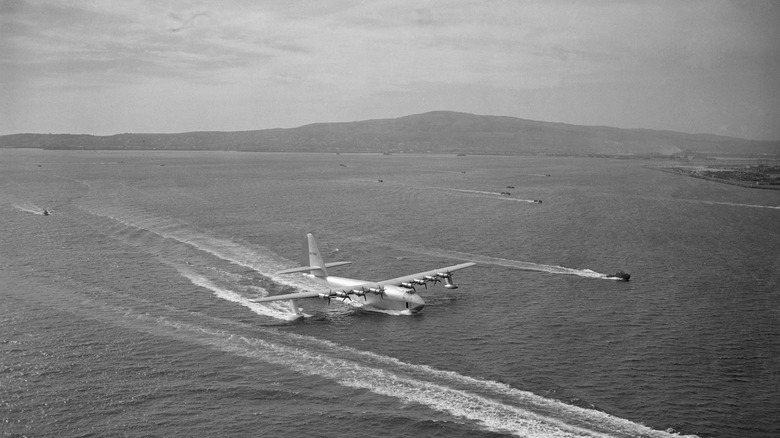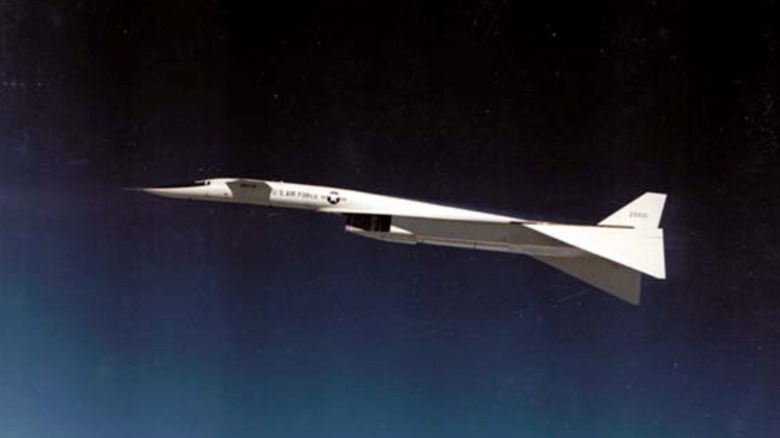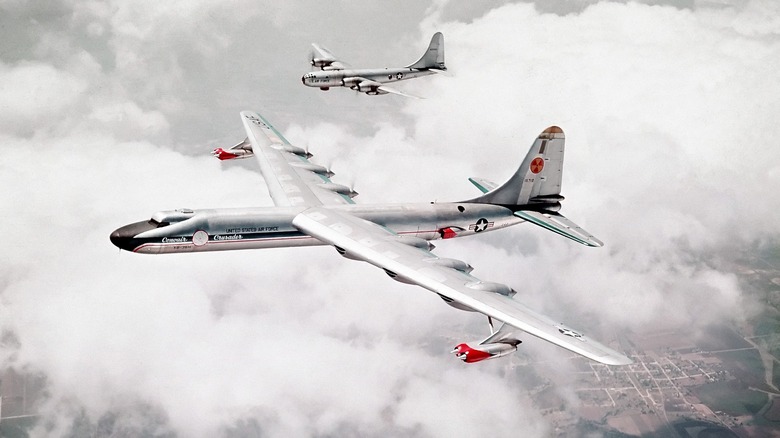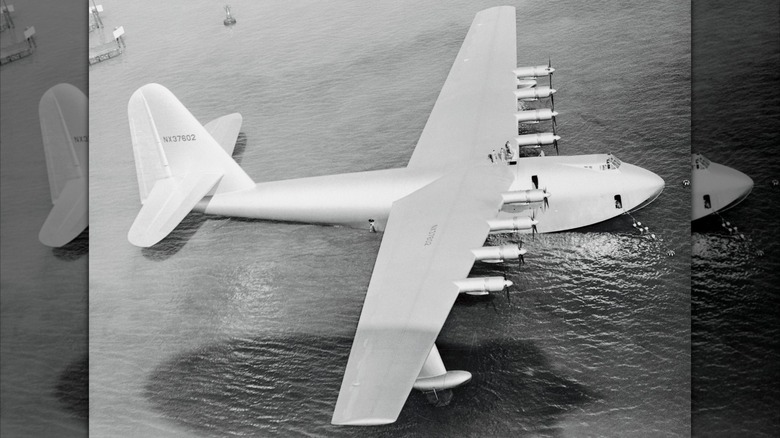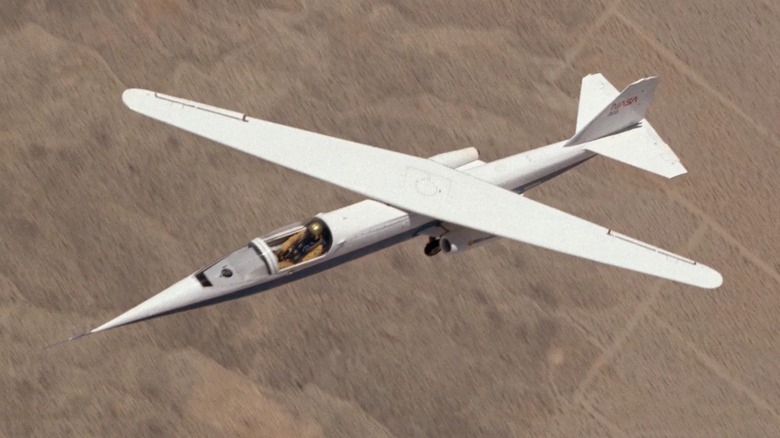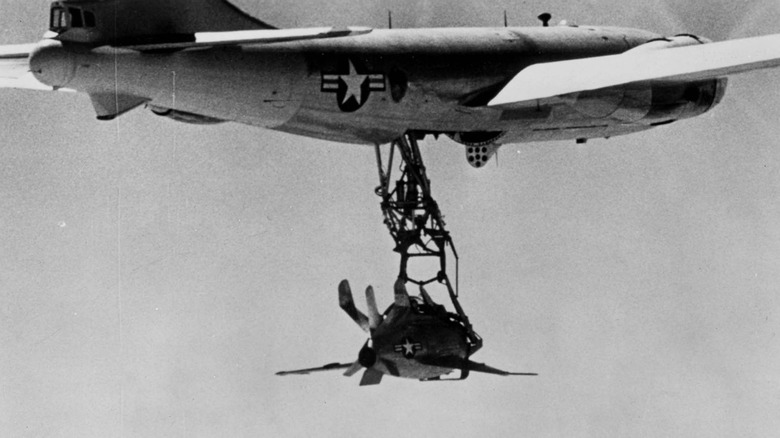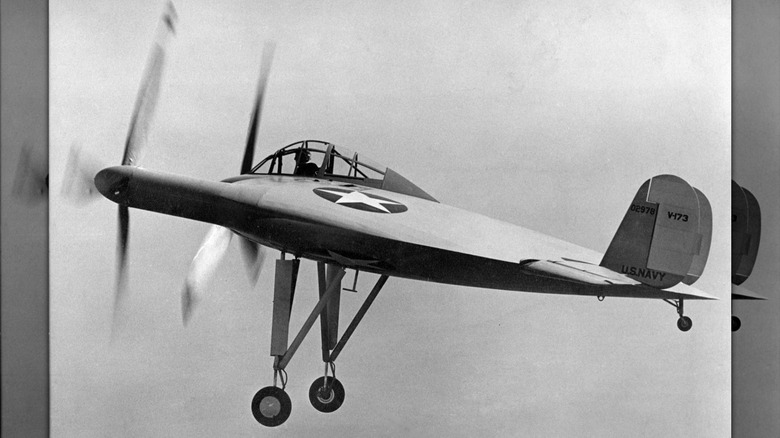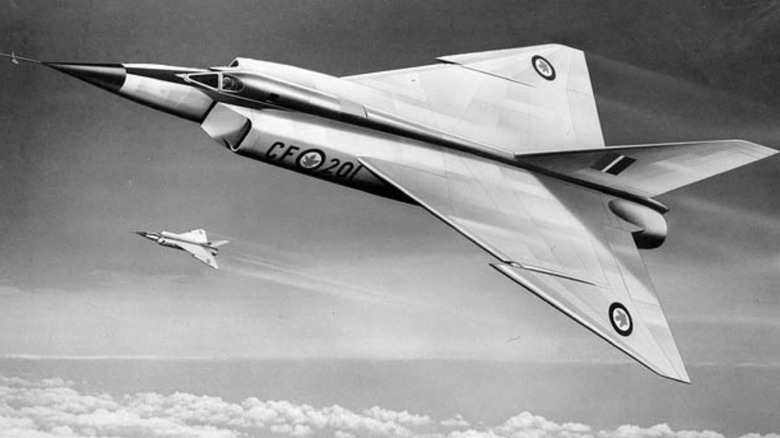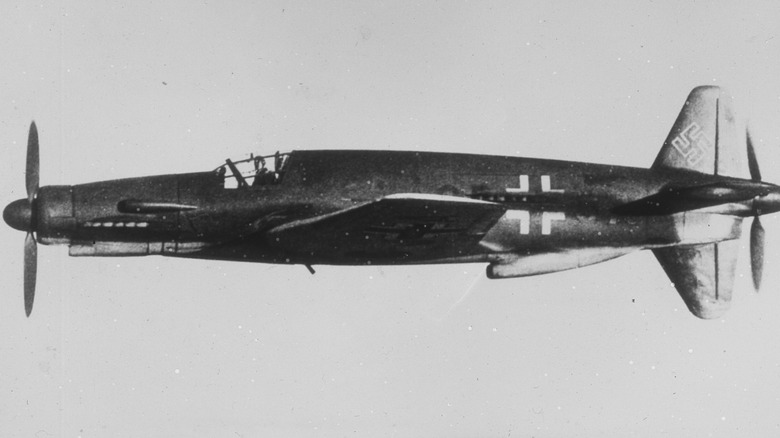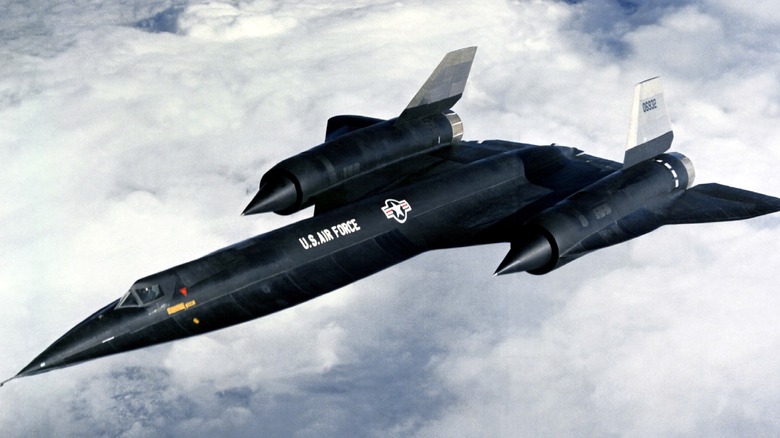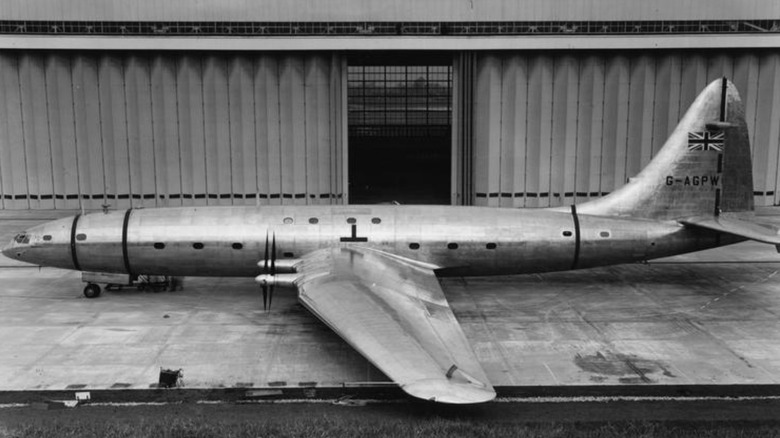10 Of The Rarest Aircraft Ever Photographed In Flight
Most of us have probably been in a Boeing 737 at some point in our lives. We have at least heard of it as it is ubiquitous. But when we look through the annals of aviation history, it turns out most aircraft are actually rare. This is especially true for military class aircraft but also applies to commercial aircraft. Many prototypes have been developed, tested, and subsequently canceled. Budget overrun, technical difficulties, changing market demands, or even a fluctuating political climate can all result in an aircraft never being mass-produced and languishing in obscurity.
Here, we explore 10 of the rarest aircraft ever photographed in flight. The list takes us on a journey through the 20th century, particularly World War II and the Cold War. It tells the story of the bold vision of designers and engineers, of pioneering technologies, of premature obsolescence. Though these machines saw limited production and short operational lives, they are still extraordinary. They epitomize innovative design, cutting-edge technology, and raw ambition.
These rare aircraft, from colossal cargo planes to diminutive fighter jets offer a glimpse into the trials and the tribulations of their time. Indeed, they are a product of their time and embody the triumphs and tragedies faced by their creators. They have left an indelible mark on aviation history and—most importantly for this article—they have all been photographed in flight, ensuring their memory remains for posterity.
North American XB-70 Valkyrie
Deriving its name from Norse mythology, the XB-70 Valkyrie had lofty ambitions of becoming a celestial warrior commanding the heavens. Unfortunately, those hopes came crashing to the ground, literally and figuratively.
Developed in the late 1950s in the context of the Cold War arms race between the U.S. and the Soviet Union, it was designed as a supersonic strategic bomber intended to outrun and outfly Soviet defenses. With its delta-wing design and 6 powerful general electric YJ93-GE-3 engines, it could fly at 70,000 feet and reaching Mach 3 speeds—an incredible performance for the time. It was constructed from advanced materials that could withstand the stress of sustained supersonic flight.
The design was groundbreaking and it was an engineering marvel. But only two prototypes were ever made. There was pushback from the Johnson administration, which felt it was a very expensive way to achieve its intended goals. Technological difficulties, ever-increasing costs, and most importantly the development of intercontinental ballistic missiles (ICBMs) and surface-to-air missiles (SAMs) rendered the program obsolete.
Of the two that were built only one survives to this day. One was lost during a formation flight on June 8th, 1966. Two pilots were killed in the mid-air collision. The crash was caught on camera, as was the Valkyrie before the crash. The remaining aircraft, housed at the National Museum of the United States Air Force in Dayton, Ohio, symbolizes the relentless pursuit of technological supremacy during the Cold War.
[Featured image by U.S. Air Force via Wikimedia Commons | Cropped and scaled | CC BY 2.0]
Convair NB-36H
With the dawn of the atomic age in 1945, the potential for atomic power was both limitless and untested. Atomic energy could be used for bombs, but what else? Powering aircraft? Potentially.
The Convair NB-36H, developed in the early 1950s, was designed to test the feasibility of a nuclear-powered bomber. A product of Cold War aspirations, it aimed to extend the range of strategic bombers and explore the safety of operating a nuclear reactor in an aircraft. Nicknamed "The Crusader", it was part of the broader Aircraft Nuclear Propulsion (ANP) program and was very much experimental not operational. Only one was ever made.
The aircraft carried a 1-megawatt nuclear reactor onboard. It didn't use the reactor to power its engines. The primary mission was to evaluate the effects of radiation on the systems and crew. It was hoped this would prove the viability of nuclear-powered flight. The reactor was installed in the bomb bay and was heavily shielded by 11 tons of lead and rubber. The cockpit featured leaded glass windows and heavy shielding to protect the crew.
Although the program was innovative, the technical and environmental challenges of operating a nuclear reactor in a military aircraft were deemed insurmountable. Technological advances were also occurring concurrently which rendered the nuclear-powered bomber obsolete before it was ever operational. It conducted 47 test flights between 1955 and 1957 but the program was ultimately canceled.
Hughes H-4 Hercules (Spruce Goose)
As the adage goes, "Desperate times call for desperate measures." Following the U.S. entrance into World War II, the government commissioned the Hughes Aircraft Company to build a cargo plane. It needed to be a large flying boat capable of carrying hundreds of men and mass materiel over long distances. No problem, thought Howard Hughes, the man entrusted with the project.
But there was at least one problem. Access to steel and aluminum was limited due to wartime restrictions. Thus, Hughes elected to build the Hughes H-4 Hercules out of birch and spruce—hence the nickname "Spruce Goose". The aircraft aimed to bypass the threat of German submarines on maritime routes. It was a machine of superlatives. It was the largest aircraft ever made at the time. To this day, it remains the largest seaplane, wooden plane, and propeller-driven plane ever made. It had a wingspan of 320 feet — almost inconceivable in scale.
More problems came to the fore throughout development. For one, the war ended. Ostensibly good news for everyone, it rendered the aircraft pointless before it was ever produced. Production delays and ever-increasing costs plagued the aircraft and it wasn't ready until 1947, a full two years after the war ended. It flew only once for 27 seconds and just at an altitude of 70 feet. This solitary flight showed, at least, that the wooden behemoth could indeed fly, but it never entered production or saw active service. The Spruce Goose can still be seen at the Evergreen Aviation & Space Museum.
NASA AD-1
Though airplanes come in all different shapes and sizes, one connecting thread in their design is symmetry: Indeed, if we saw an aircraft where both sides weren't an exactly the same, we would have cause for concern. How can an asymmetrical monstrosity get airborne?
The NASA AD-1's main contention was that asymmetry would offer superior aerodynamic performance. Influenced by the theories of aerodynamicist Robert T. Jones, NASA's aircraft aimed to reduce drag and enhance fuel efficiency. It was a small aircraft, with a wingspan of 32 feet and a length of 38 feet. Featuring a pivoting oblique wing that could rotate from 0 to 60 degrees, the plane could align the wing to optimize airflow at different speeds.
Only one was ever made and NASA conducted 79 test flights between 1979 and 1982. Overall, the results were a mixed bag. Sure, NASA proved that an oblique wing design could offer superior aerodynamics over its symmetrical fixed-wing cousins. However, its handling was less than ideal at low speeds and extreme angles. More concerningly, the severe structural stresses imposed on the aircraft rendered any aerodynamic benefits a moot point.
Given these concerns, it is not surprising that the oblique wing design has never taken off. But it exemplifies NASA's innovative spirit and eagerness to investigate unorthodox ideas in pursuit of advancing aeronautics. Today, the NASA AD-1 is preserved at the Hiller Aviation Museum in San Carlos, California.
McDonnell XF-85 Goblin
Another bizarre addition to the list, the McDonnell XF-85 Goblin is the smallest fighter jet ever made. Conjuring images of the tiny male angler fish attaching to the navel of its larger female mate, the XF-85 is also known as the "parasite fighter". It was developed in the late 1940s to be deployed from the bomb bay of a Convair B-36 Peacemaker bomber. It would defend the bomber from enemy fighters before redocking.
It was incredibly compact and extremely agile at only 14 feet long with a wingspan of 21 feet. Its single Westinghouse J34-WE-22 turbojet engine provided enough thrust to reach speeds of 650 mph. It was also designed to be a capable fighter, armed with four .50 caliber machine guns. There was no landing gear, as it was designed for deployment and redocking mid-air.
Only two prototypes were ever built and they were tested in 1948. The tests were a failure, though, as pilots experienced major difficulties with turbulence and the docking procedures. Like other planes on our list, concurrent technological developments offered better, cheaper solutions. The emergence of long-range escort fighters and advanced missile technology scuppered any potential for the XF-85. Both prototypes are preserved in museums, with one on display at the National Museum of the United States Air Force in Dayton, Ohio, and the other at the Strategic Air Command & Aerospace Museum in Ashland, Nebraska.
Vought V-173 Flying Pancake
The innovations of war result in some weird and wonderful developments. The Vought V-173, also known as the "Flying Pancake" has become one of the most distinctive experimental aircraft in aviation history. Developed during World War II, it was part of a broader effort to explore unconventional aircraft design for superior performance. Specifically, it aimed to minimize takeoff and landing distances and provide.
Constructed from wood and canvas, its unique disc-shaped design rendered it singularly well-suited to the task. Its entire body generated lift. The aircraft was all wing. It was also set at a steep upward angle to accommodate the huge propellers, which provided even more lift. These propellers were powered by two 80-hp Continental A-80 radial engines. First flown in 1942, the result was phenomenal lift and impressive take-off and landing capabilities. It also demonstrated stability and control at low speeds. However, there were several concerns about the aircraft. Most notably, at higher speeds, it suffered from vibrations and handling issues.
And like so many other planes on our list, parallel technological developments took precedence and the program was discontinued. Simply put, it was never going to be able to compete with the jet engine. Propeller-driven disc aircraft, though a fantastic proof of concept, quickly fell out of favor. All focus instead centered on emerging jet propulsion technologies. Today, the Vought V-173 is preserved at the Frontiers of Flight Museum in Dallas, Texas, a testament to the strange innovations of war.
[Featured image by U.S. Navy via Wikimedia Commons | Cropped and scaled | CC BY 2.0]
Avro Canada CF-105 Arrow
The Canadians may not be known for cutting-edge military research and development, but in the 1950's they developed an aircraft so advanced it became known as one of the best fighter jets of the Cold War.
The Avro Canada CF-105 Arrow is legendary. It represented a huge technological leap for the Canadians and it featured advanced aerodynamics, powerful engines, and sophisticated avionics. Its delta-wing design allowed for excellent high-speed performance and handling. It could fly at Mach 2 and an altitude of 50,000 feet. It was a hugely impressive technological achievement that represented Canada's entry into the aviation elite and heralded a future of aerial supremacy.
But then disaster struck. On Feb. 20, 1959, a day that became known as "Black Friday" in Canada, the program was abruptly canceled. It turned out that developing cutting-edge supersonic jet fighters was expensive. The army and navy disapproved of the program because it took money out of their budgets. Due to escalating costs, changing priorities, and political pressure, the government ultimately agreed that the project was simply too expensive. Overnight, 14,000 top engineers were all out of work. Through brain drain, many of these simply moved south to the U.S., and some ended up working on NASA's Apollo program. As for the aircraft, only five were made, and they were all destroyed following the cancellation of the program.
[Featured image by National Film Board of Canada via Wikimedia Commons | Cropped and scaled | CC BY 2.0]
Dornier Do 335 Pfeil
World War II saw an incredible amount of technological advancement. Sometimes this involved developing entirely new technologies like the jet or the rocket or splitting the atom. Other times it involved tinkering with current technology, optimizing it, and squeezing every last ounce of performance possible from it. The Dornier Do 335 Pfeil, known as the "Arrow" falls into the latter category.
It was a German fighter bomber developed towards the end of the war. Its central feature was its unique push-pull engine configuration. This allowed both engines to be installed in the fuselage—one at the front, one at the back—rather than loading one on each wing. It helped massively reduce drag and meant the Pfeil could reach speeds of up to 474 mph. This was the fastest piston-driven aircraft of the war and was heavily armed.
It was an impressive aircraft and would've surely made quite an impact in different circumstances. However, development began too late to be effective. The Allies had already gained air superiority over Europe. The Germans' capacity to produce had been severely eroded as the country was near collapse. The war was already lost and Hitler was well on his way to his bunker. But the Allies captured and evaluated the plane and it has earned a reputation as a technological marvel. Today, the sole surviving Do 335 can be found at the Smithsonian National Air and Space Museum in Virginia.
[Featured image by Dia_240-226 via Wikimedia Commons | Cropped and scaled | CC BY-SA 4.0]
Lockheed A-12 Oxcart
Sometimes military R&D is so secret that no member of the public is even aware of its existence until years later. Project Oxcart, is one such example. The project aimed to develop the Lockheed A-12, an aircraft designed in profound secrecy. Like any classified military development worth its salt, it was tested extensively at Area 51. Details of its development were eventually declassified in 1991, nearly 30 years after its initial deployment.
So what do we know about it? Part of the Blackbird family, it was a highly advanced reconnaissance aircraft developed by the CIA in the early 1960s. As a precursor to the SR-71 Blackbird, it pioneered high-speed, high altitude, surveillance technology during the Cold War. With its unique shape and paint, it was also a stealth aircraft able to avoid detection by radar. It could reach 85,000 feet and fly at over Mach 3. Made primarily from titanium it was well suited to high-altitude, high-speed operations. First flown in 1962, it entered service in 1967 and conducted reconnaissance missions over North Vietnam and North Korea.
Despite its operational success, it was phased out by the SR-71 after just a few short years in service. Only 15 were ever made and its existence remained classified for many years. Today, several A-12 aircraft can be seen in museums, including the Intrepid Sea, Air & Space Museum in New York City, and the California Science Center in Los Angeles.
[Featured image by DVIC via Wikimedia Commons | Cropped and scaled | CC BY 2.0]
Bristol Brabazon
From small sailing ships, to ocean liners, to passenger jets, we have seen Trans-Atlantic travel times cut exponentially. A journey that took Columbus several months took Concorde three and a half hours. Now, the Concorde no longer exists, but clearly speed is important. It wasn't an important consideration for the developers of the Bristol Brabazon, much to their chagrin.
Developed just before the jet age, the designers, unfortunately, adopted the philosophy of the ocean liner age. That is to say, they focused primarily on providing unparalleled luxury and comfort for long-distance travel when designing the Bristol Brabazon. Travel time and ticket price were secondary concerns. It could accommodate 100 passengers and featured spacious seating, a dining room, and even a lounge with a grand piano. It was the largest aircraft ever built in the U.K. Its maiden flight was in 1949 and it was successful in a technical sense.
But in every other sense, the airplane was an abject failure. Unfortunately for the Brabazon, the winds of change were blowing in another direction and the post-war boom in commercial aviation favored smaller, cheaper aircraft that could carry passengers at more affordable prices. The hubris of the designers meant they misread the market and were far too ambitious in their design. It was an extremely expensive miscalculation and in the end, only one was ever made. Ultimately, the project was scrapped in 1953 and the only existing prototype was dismantled.
[Featured image by U.K. Government via Wikimedia Commons | Cropped and scaled | CC BY 2.0]
